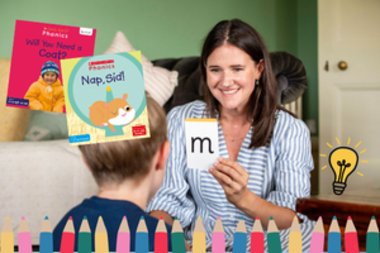Introducing the Daily Reading Lesson
I have always been a reader. One of my earliest memories is sitting with my dad as a pre schooler as he taught me to read. As an older child, I was never without a book. So much so, that I would read in bed by torchlight and earned myself the nickname of Bookworm at my gymnastics classes for reading my book between the different apparatus practises. Reading has shaped me; it has made me the person I am today and I am still never without a book.
As an educator, I want all children to love reading as much as I did as a child. Not simply because reading will allow them to experience the world around them but because I know from research (for example, OECD, 2002) that children who read for pleasure go on to achieve more highly than children who do not. Reading for pleasure, then, is a vital part of a child’s future success and it is something that we should work hard to achieve for all of our children. But just as my reading journey began with my dad teaching me to read, as teachers and school leaders we need to ensure that our pupils are taught how to read so that as well as having the will, they also have the essential skills to read.
It is emphasis on using pedagogical approaches to teach the skills of reading that is the driving force of the Daily Reading Lesson, a new high-impact, low-workload blueprint to teaching reading to children from ages six to 11 that I have authored for Scholastic. It carefully considers the findings of Scholastic Reading Audit: Key issues and trends in the teaching of reading which identified a number of trends that suggest additional support is needed in some primary schools to focus more on how reading is taught to children, and the policies, training and resources we use to support this.
So what is the Daily Reading Lesson?
The Daily Reading Lesson provides primary leaders and teachers with a blueprint for successful, robust and evidence-based teaching that leads to higher outcomes, with the benefit of lower teacher workload. It presents a model that can be applied in every classroom, enabling every teacher to develop deeper knowledge of teaching children to read as well as giving the best teachers the freedom to thrive and adapt to the needs of their children.
The approach uses popular reading strategies (shared reading, guided reading, repeated reading and reciprocal reading), each of them grounded in research and selected for their ability to deliver high-quality lessons with minimal preparation. These strategies are used in a reading rotation to ensure that children learn from their teacher, with their teacher or teaching assistant, and as part of a group working independently of adults. They develop a range of reading skills so that they learn to decode, extend their vocabularies, comprehend what they read and develop their oracy and fluency skills; all while enjoying what they read.
The Daily Reading Lesson recognises that no single approach to teaching reading delivers all desired outcomes. Instead, the lesson helps schools meet the needs of pupils by combining whole-class teacher-led methods with small-group tuition and independent work. In this way, the best features of all the approaches are combined for the greatest possible child outcomes.
Ideally, the Daily Reading Lesson requires one teacher and one teaching assistant in order to get the most out of each lesson, but it is also adaptable for schools that do not have the resources to support this. While schools can use their own resources, Scholastic has sourced and created high-impact teaching resources from around the world to support the Daily Reading Lesson, which you can download here.
I have the immense privilege in my professional life of working with teachers and school leaders on all aspects of reading. It is through this work that I get to see the incredible achievements of children borne out as the fruits of their teachers’ efforts. It also means that I have also experienced a whole range of approaches to reading which ensure that children master the skills required to become successful readers. It is these experiences that have helped me to craft the Daily Reading Lesson.
This model helps teachers and leaders improve the reading performance of children, with the aim of creating rounded readers who enjoy books and reading for pleasure. It is my firm belief that if we can teach our children how to read, we can forge a future for them that is not only literate but also fulfilling and successful.

Rachel Clarke is an independent literacy consultant in Primary English and author of the Daily Reading Lesson and the Scholastic Reading Audit.
Similar Posts
-

Reflections on the teaching of reading
In this guest blog post, Maddie Towne, a Year 6 Teacher and English Lead at Fossebrook Primary School reflects on her experiences of the teaching of reading.
-

Scholastic Reading Audit: Key issues and trends in the teaching of reading
Five years ago, Scholastic published the Scholastic Reading Audit, a free tool to support schools in the teaching and leading of reading. Our 2021-2022 summary report is now…
-

Phonics Books: What Parents Need to Know
Miss Mabel from Reading Roots explains how to choose the right books for early reading success
